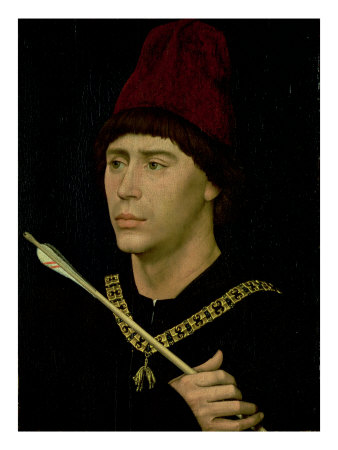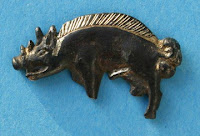
I'm sure everyone is aware of the recent press coverage that the Bosworth battlefield site has been 'rediscovered', or more accurately relocated, to about 2 kms from the current site near Ambion Hill. I attended last weekend a oneday conference on the battle that followed up on the media coverage of the Battlefield Trust's work to review the battle site. What follows is a brief review of what I found to be the most interesting points made by an excellent line-up of speakers and academics. Read on if you're interested...
Richard Holmes (military historian) - his excitement about the event was the way that a number of disciplnes had all come together to inform on the battlefield - historians, archeologists, re-enactors, geographic analysis etc. Holmes sees this as the way forward now for sites where there is little direct recorded evidence; basically those in UK before the 17th centuty. On Bosworth he still has questions to be answered about why Richard lost a battle he should have won and why he left a good position on Ambion Hill, where he encamped the night before? On the latter he sees the role of Stanley, who Richard expected to join Henry Tudor, as the key as it forced him to act and attack.
Anne Curry (Southampton University) - gave update on work to assess size of armies, using what direct info exists and what can be derived from other accounts, notably 1475 indentures for Edward IV's french campaign. On Richard's army, Curry noted apparent low numbers of commissions of array and few peers at the battle, suggesting a likely dependence on few peers (Norfolk and Northumberland) and the royal household. Lower volume of arrayed troops may have reduced numbers of archers in the royal army? - army list writers take note! A source shows that an order was made to bring serpentines from Calais - which could be the guns that fired the cannonballs found on the site? Henry's army includes more nobility, many collected en route to the battle, and 'Franc Archers' (maybe 1-2,000?), and there was discussion about their potential tactics, as they were Swiss trained, to out-flank or attack the royal artillery. Overall 259 named leaders are known to have been at Bosworth and more work to be done to build up size of contingents.
Matthew Strickland (Glasgow University) - went thru the contmporary materials and possible military tactics, based on those of the 15th century. The typical composition was a strong 'van', which Vergil says at Bosworth was strong with archers for both armies. Apparently there is work underway reviewing whether in English battles of period archers and men-at-arms fought in their 'lance', eg with a couple of archers side-by-side assisting as a tactical unit - rather than being banded together as large bow units - which could challenge our wargame rules and basing! Strickland's summary was that success in WotR battles was likely to go to the army who could get the opposition to attack them and that defensive tactics was the traditional mind-set of most leaders.
Derek Allsop - reported on experimental firing tests, using cannonballs that match those found at Bosworth. When fired, just 1 degree of elevation of a gun barrel added over 100% to the distance that a ball travels before hitting the ground. Whilst the balls hit the ground around 250 metres, when tested they carried on for 1 km, boucing about 8-10 times, before stopping! Deviation side-to-side was minimal. Therefore more work to be done using forensics used on bullets to show what happened to the Bosworth shot, so that the possible position that they were fired from can be decided, ie where was the artillery positioned?
Glenn Foarde (Battlefield Trust lead archeologist) - went thru how historic maps had made assumptions on the battle site and how reference to the marsh has misled historians. The BT survey focussed on placenames and geographic surveys to find where the marsh had been (apparently not a large one at all, so question on what impact it may have had on the troops positioning and not found as drained in 1530!). More work planned to try and find out where the guns were. also the search hasn't looked for arrowheads, to find the main location of the fighting, as has been done at Towton. Full report by Glenn is in this months BBC 'History' magazine.
Finally a plug for the Battlefield Trust, http://www.battlefieldstrust.com/ which I joined a few months ago; it backed this project and does a great job preserving and developing UK sites. Why not join today!
Normal service will be resumed asap, am still applying the acrylics when time allows...




